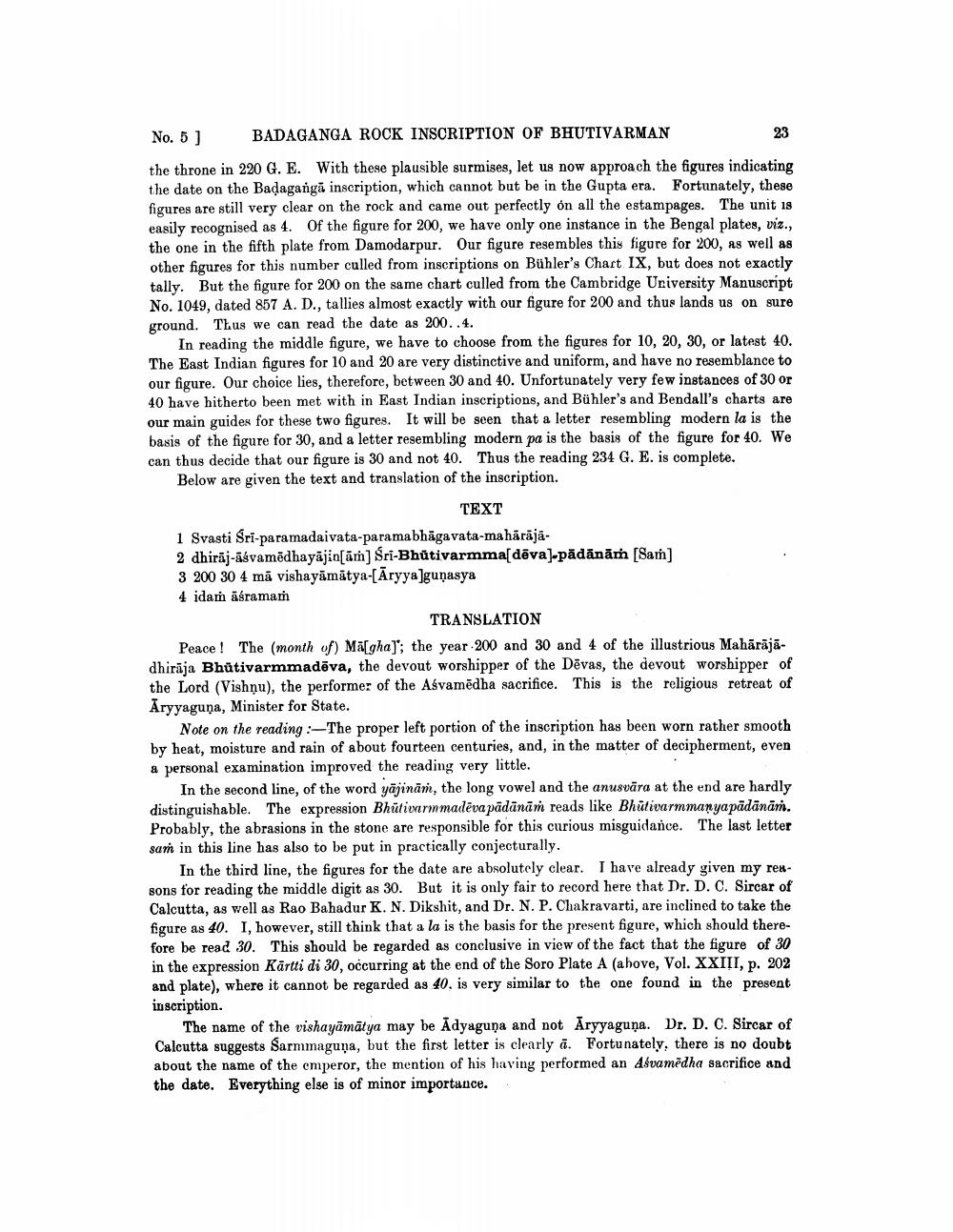________________
No. 5 ] BADAGANGA ROCK INSCRIPTION OF BHUTIVARMAN the throne in 220 G. E. With these plausible surmises, let us now approach the figures indicating the date on the Badaganga inscription, which cannot but be in the Gupta era. Fortunately, these figures are still very clear on the rock and came out perfectly on all the estampages. The unit 18 easily recognised as 4. Of the figure for 200, we have only one instance in the Bengal plates, viz., the one in the fifth plate from Damodarpur. Our figure resembles this figure for 200, as well as other figures for this number culled from inscriptions on Bühler's Chart IX, but does not exactly tally. But the figure for 200 on the same chart culled from the Cambridge University Manuscript No. 1049, dated 857 A.D., tallies almost exactly with our figure for 200 and thus lands us on sure ground. Thus we can read the date as 200..4.
In reading the middle figure, we have to choose from the figures for 10, 20, 30, or latest 40. The East Indian figures for 10 and 20 are very distinctive and uniform, and have no resemblance to our figure. Our choice lies, therefore, between 30 and 40. Unfortunately very few instances of 30 or 40 have hitherto been met with in East Indian inscriptions, and Bühler's and Bendall's charts are our main guides for these two figures. It will be seen that a letter resembling modern la is the basis of the figure for 30, and a letter resembling modern pa is the basis of the figure for 40. We can thus decide that our figure is 30 and not 40. Thus the reading 234 G. E. is complete.
Below are given the text and translation of the inscription.
TEXT 1 Svasti Sri-paramadaivata-paramabhägavata-mahārāja2 dhirāj-āśvamēdhayājin[ām] Śri-Bhűtivarmma[ dēva)-pādānāṁ (Sam) 3 200 30 4 mā vishayāmātya-[Aryya]guṇasya 4 idam asramam
TRANSLATION Peace! The month of) Mä[gha)'; the year 200 and 30 and 4 of the illustrious Mahārajādhiraja Bhūtivarmmadēva, the devout worshipper of the Dēvas, the devout worshipper of the Lord (Vishnu), the performer of the Asvamēdha sacrifice. This is the religious retreat of Aryyaguna, Minister for State.
Note on the reading :- The proper left portion of the inscription has been worn rather smooth by heat, moisture and rain of about fourteen centuries, and, in the matter of decipherment, even a personal examination improved the reading very little.
In the second line, of the word yājinām, the long vowel and the anusvāra at the end are hardly distinguishable. The expression Bhūtiurmmadēva pādānāṁ reads like Bhülivarmmanyapādānān. Probably, the abrasions in the stone are responsible for this curious misguidance. The last letter sam in this line has also to be put in practically conjecturally.
In the third line, the figures for the date are absolutely clear. I have already given my redsons for reading the middle digit as 30. But it is only fair to record here that Dr. D. C. Sircar of Calcutta, as well as Rao Bahadur K. N. Dikshit, and Dr. N. P. Chakravarti, are inclined to take the figure as 40. I, however, still think that a la is the basis for the present figure, which should therefore be read 30. This should be regarded as conclusive in view of the fact that the figure of 30 in the expression Kärtti di 30, occurring at the end of the Soro Plate A (above, Vol. XXIII, p. 202 and plate), where it cannot be regarded as 40. is very similar to the one found in the present inscription.
The name of the vishayāmātya may be Adyaguna and not Āryyaguna. Dr. D. C. Sircar of Calcutta suggests Sarmmaguna, but the first letter is clearly a. Fortunately, there is no doubt about the name of the emperor, the mention of his having performed an Afvamëdha sacrifice and the date. Everything else is of minor importance.




